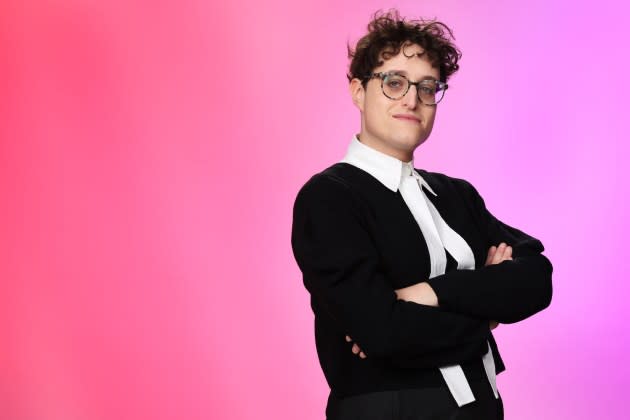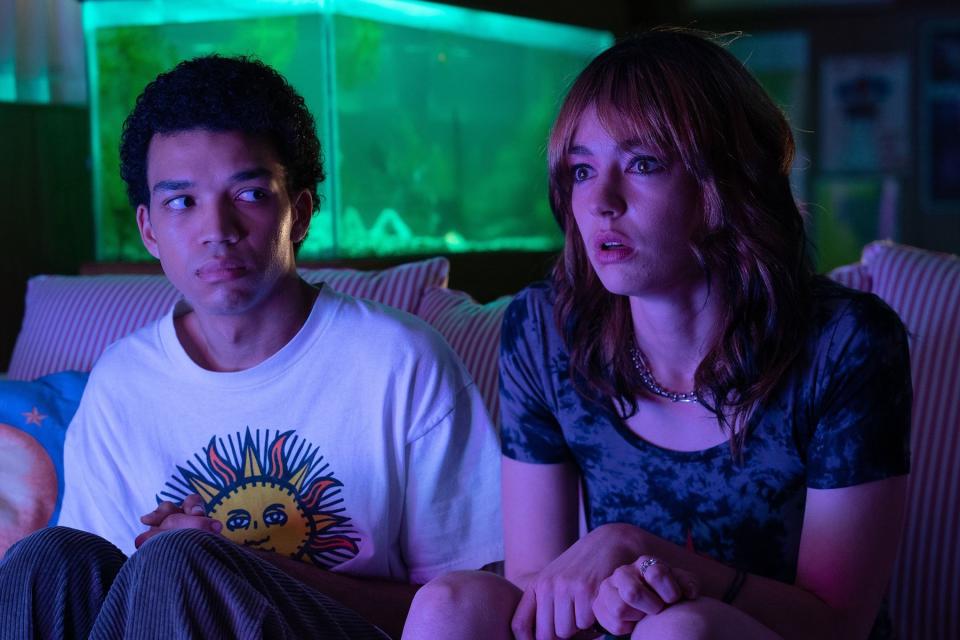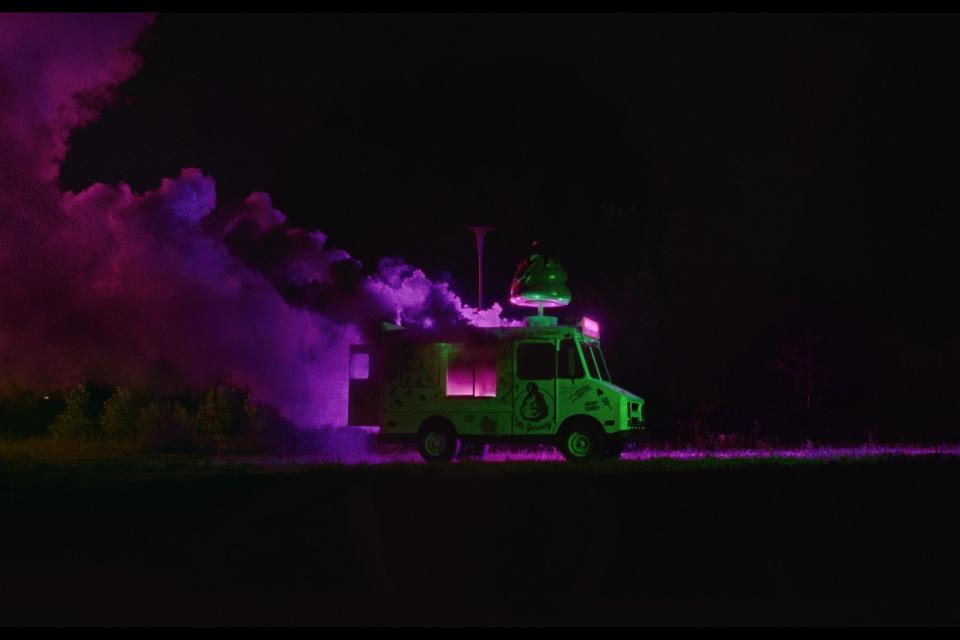Jane Schoenbrun Made Sundance’s Hottest Horror Movie About Their Trans Experience
- Oops!Something went wrong.Please try again later.
- Oops!Something went wrong.Please try again later.

In the fall of 2021, filmmaker Jane Schoenbrun found themselves back in their hometown, walking the streets of Ardsley in Westchester County, New York, with a disposable camera in hand. They’d taken a day trip up from Brooklyn in the hopes of revisiting the places that had once defined their adolescence. A lot had changed since their teenage years. Now Schoenbrun was wandering through the town — “a classic American suburb, built to keep people sheltered from the real world,” they say with a laugh — as a trans and nonbinary person, roughly a year into their physical transition.
“I went back and wandered around the movie theater I used to work at, and the shitty arcade that somehow still exists where I had my seventh birthday party, and I kind of communed with the person I was when that was the only world I had access to,” they recall.
More from Rolling Stone
Sex, Drugs, and Sitar Fights: How 'DIG! XX' Explodes and Rebuilds a Cult Rock Doc
How Shiori Itō Took on Her Powerful Rapist and Changed Japan Forever
Conservatives Are So Scared of Diversity They're Starting to Boycott 'Woke' Airlines
The suburbs serve as the backdrop for Schoenbrun’s latest film, I Saw the TV Glow, a surreal coming-of-age horror film produced by A24 and Emma Stone’s Fruit Tree production banner, which has already become one of the buzziest features out of Sundance since its premiere.
A dizzying labyrinth of Nineties pop culture, the film follows teenagers Owen (Justice Smith) and Maddy (Brigette Lundy-Paine) who forge a friendship over the TV show, The Pink Opaque, a supernatural teen drama that feels like a blend of Buffy the Vampire Slayer and Are You Afraid of the Dark?, complete with monsters of the week and deliciously angsty teen music. Outsiders trapped in suburbia, Maddy and Owen turn to The Pink Opaque first as an escape, but then as a kind of religion, seeing themselves in the show’s heroines, Tara (Snail Mail singer Lindsey Jordan) and Isabel (Helena Howard). From there, the film descends into a surreal Lynchian nightmare as the lines between the show and reality start to blur. While Maddy embraces this slippage and comes into her own, Owen retreats further and further into a town and a body he’s never felt quite at home in.
Schoenbrun’s work often explores and interrogates our relationships to screens, including in their breakout film, We’re All Going to the World’s Fair, which was steeped in the world of online creepypasta communities. Like their latest, it was also rooted in Schoenbrun’s own experiences as a queer and trans person navigating the world.
Dire and inventive, I Saw the TV Glow is about the media that defines us, saves us, and shows us who we are, even when we’re not ready to admit it. It’s a meditation on dysphoria, and the lifelines queer and trans people often cobble together out of music, TV, and film to find ourselves in places and times when we feel alone. Rolling Stone spoke with Schoenbrun about their “Pink Opaque” and the delicate balance between finding refuge in fantasy and letting it consume you.
This film feels like it’s in conversation with so many Nineties and early 2000s cultural touchstones, from Twin Peaks to The Smashing Pumpkins and Donnie Darko. What brought you back to that moment in time?
In starting to transition, and becoming the kind of person who could never fit in the place I grew up — not that I ever was someone who fit in — I was reflecting back on my childhood and the places where I first learned what it was to be a person. That all happened to me in the suburbs, and through the screen.
Growing up in this very homogenized place, I was being fed stories on television and through music that were trying to mythologize the suburbs into something romantic and beautiful and strange and sometimes creepy. Those glimpses and shimmers that I caught, especially in Nineties television, were as much a part of the mythology of my youth as the real places that I was inhabiting.

For so many queer people, entertainment and media can be critical to discovering who you are. Your film gets at the highs of that idea, but it also explores the lows. Why did you want to go there?
People say “write what you know,” and this is what I know. I was the queer kid who was repressed and fully disassociating through various media that felt like family or friends or home to me. My work is very much about the complex question of entertainment, and as a proud anti-capitalist, I think it’s hard to take an honest look at America’s current relationship to entertainment and media and not see a lot of darkness there.
I think with my first film, I had developed this metaphor of the screen as a symbol of that kind of dissociation that we as trans people do before we’re ready to become ourselves. So thinking back on my obsession with Buffy the Vampire Slayer, or Are You Afraid of the Dark?, and the way that those TV shows more than defined my youth, but sort of stood in for my youth, it just felt like a really potent way to talk about spending your life watching yourself on a screen until you’re ready to face the uncertain, but exciting prospect of living it.
What was going on in your life at the time that made you want to examine things through that lens?
I refer to it as an “egg crack” movie, which is a term in the trans community for the moment when you, forgive me, “see the TV glow,” or see yourself in a way that you can’t unsee. I think for many years, if you’d asked me “Would you like to not be a boy? Would you rather be a girl?” I would have said, “Of course. But that doesn’t make me trans.” It kind of does. [Laughs]
I do think it was a matter of survival, that I wasn’t fully equipped to be “un-repressed” in my younger years. So once that wall finally fell, it threw my entire sense of reality, of home, of family, community, into a really wild and overwhelming flux. It was incredibly exciting, because I knew that I was running toward a full existence in a way that had been denied me for a long, long time. And it was absolutely terrifying because it meant completely blowing up my life and facing almost certain social death, at least within the world I had been existing within. That was the backdrop to writing the film.
It was incredibly exciting, because I knew that I was running toward a full existence in a way that had been denied me for a long, long time. And it was absolutely terrifying because it meant completely blowing up my life and facing almost certain social death, at least within the world I had been existing within.
As adults, I feel like there’s a tendency to look back on your emotions or the intensity of them as a teenager and downplay them, or write them off. I loved that the movie takes adolescence and imagination really seriously, and kind of challenges the viewer to put themselves back there.
I never want to make movies that speak down to experiences. If this movie, this TV show, the mystery and romance of it felt in any way like I was just leaning on pastiche, or trying to talk down or make fun, I don’t think the movie would work at all. I always said that we weren’t trying to recreate those shows as they actually existed, we were trying to create the sense of how it felt to watch them.
What was it like to revisit those references and kind of create your own version of the shows you were obsessed with through The Pink Opaque?
I could have paid homage to specific moments or aesthetics from those TV shows, like having Tara say a snappy one-liner and swing an ax toward the camera, which is obviously referential for something like Buffy. But in a wider sense, those shows meant something to me because they made me feel a little less alone. Taking what I’ve learned from them while reflecting on what felt beautiful about them and making them my own, I think any artist does that. We’re continuing the conversation with the things that first showed us that glow that we found ourselves in.
I really want to ask you about the music. I mean, what we hear in the movie are these hazy, gritty tracks that feel right out of the time period, and then we even get a whole Phoebe Bridgers and Sloppy Jane performance at one point. You gave composer/musician Alex G a mixtape to work off for the score. What kind of artists were on it?
I mean, I’m a complete music nerd to the point where my version of The Pink Opaque was downloading Bright Eyes and Neutral Milk Hotel records from Napster. I knew I wanted to make a great teen angst movie, and great teen angst movies need great teen angst music. I was listening to a lot of the music from my own high school experience: a lot of Xiu Xiu, and “Anthems for a Seventeen Year Old Girl” by Broken Social Scene. Smashing Pumpkins’ Mellon Collie and the Infinite Sadness album is a core influence on the film — just the vastness and the suburban romance of that double album and how it can envelop you was something I was really interested in trying to recreate.

A full soundtrack will be coming out later. What can you tell me about that?
Early on in the process, I pitched A24 and basically said, “I want to make the best soundtrack of all time.” I commissioned my favorite contemporary artists who were doing the kind of things that I was obsessed with when I was a teenager, and asked them to write the song that they would have written if they had played in the Bronze from Buffy or in the Roadhouse from Twin Peaks. A24 was so down, and alongside Alex G’s score, we commissioned 16 original songs from a ton of amazing artists like Snail Mail, Yeule, Bartees Strange, Sloppy Jane featuring Phoebe Bridgers, Caroline Polachek, The Weather Station, Maria BC, and the band Proper.
It was an incredible opportunity, and I’m so excited for it to come out, because I put an absurd amount of obsessive love into trying to make a soundtrack that could stand alongside Donnie Darko, or Garden State, or those early Wes Anderson and old John Hughes soundtracks, where you want to return to the movie because of the music and you want to return to the music because of the movie.
He’s not a musical performer in the movie, but Fred Durst of Limp Bizkit plays Owen’s dad, who’s definitely a distant but menacing figure in the film. Is he who you had in mind when you were writing the script?
I knew I wanted him to be the dad from the very beginning, and was quite adamant about it. I thought of it as sort of my creative white whale, like if I can make that happen, this could be the weird fever dream that I’m hoping it will be. [Laughs] Fred was amazing. He’s a film buff. Within three minutes of getting on the phone with me, he was talking about Paris, Texas and David Lynch, and hanging out with Harry Dean Stanton back in the early 2000s.
What did he bring to the table that you felt was so important to the film?
He’s an incredible performer and on screen, seeing Fred Durst carries really specific allusions to a certain moment, and a certain kind of white male anger that it was really important to have in the stew of the movie. It would be one thing to cast someone who looked like Fred Durst, but to have the man himself glaring at you from across the room, I think the opportunity to have that unique and evocative presence on the screen does something that you can’t replicate any other way.
It feels important that I Saw the TV Glow is speaking to trans and queer experiences, but also it’s not explaining or justifying itself.
Obviously, we live in a moment in this country where being trans is an incredibly fraught idea and reality for all of us. While I’ve been here at Sundance, Utah has passed a bathroom bill on the House floor to ban us from pissing. We’re quite literally under siege and endangered as a population. For me personally, being in the public sphere as a trans person working in an industry where there aren’t really any people like me across the table is a really disorienting — and also exciting — project.
I never want to make myself into a movement, but I’m incredibly proud that I get to tell honest stories, from my own perspective, with creative autonomy — stories that hopefully resonate, not just with trans audiences, but definitely with trans audiences who don’t get to see themselves very often in this way. I really do hope that that becomes a bridge toward a generation of artists who have a lot of things to say that we aren’t saying right now in our culture. There are activists and politicians, and I will gladly join their marches to keep us from dying, but I think part of the path to equality is also making work that isn’t just about the fact that we are people too, and that we deserve to be alive. That’s not something that any trans person needs to see on a screen to know that it’s true. What we need is art about the invisible experiences we have all felt that we don’t really have ways of talking about. Doing work which hopefully makes folks like me feel a little less alone is what it’s all about for me. I never set out to make something to prove some political point about transness. It’s much more that I am trans, so the work will be trans.
Best of Rolling Stone

